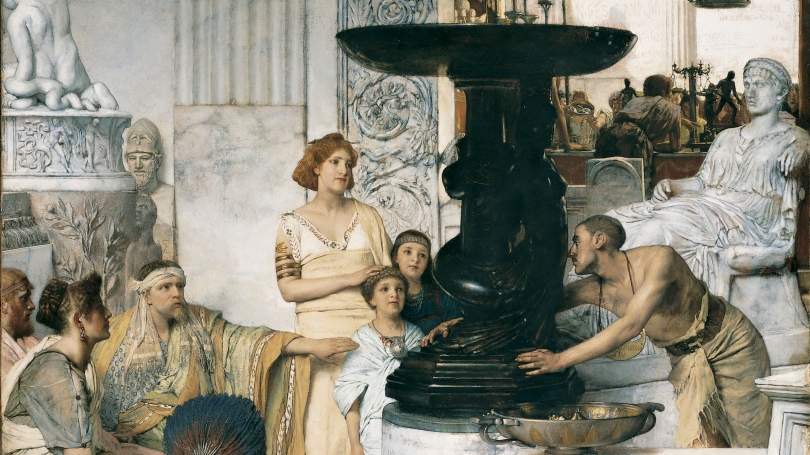Alma-Tadema and Antiquity: Imagining Classical Sculpture in Late-Nineteenth-Century Britain
Hood Quarterly, summer 2008
T. Barton Thurber, Curator of European Art
Sir Lawrence Alma-Tadema's (1836–1912) largest painting, The Sculpture Gallery, was exhibited at the Paris Salon in 1874 and the Royal Academy in 1875. It measures over nine by seven feet in its original frame, and it is one of his most ambitious compositions. The painting is a tour-de-force of illusionism, recreating with archaeological precision Roman architecture, sculpture, and decorative objects. The artist had examined many of the actual ancient works of art during his visits to Herculaneum and Pompeii in the 1860s and recorded a number of the objects in sketches and photographs. As a result, Alma-Tadema produced not only a sumptuous depiction of antique works of art in an exquisitely rendered interior but also a highly innovative painting. The accuracy of his representation and the complexity of his conception have been highlighted in this focused exhibition.
In addition to the large painting, the Hood's display includes another depiction of this theme by the artist and other related works, as well as a recently completed set of radiographs. Featured loans from the Museo Archeologico Nazionale and the Soprintendenza archeologica di Pompei include some of the original, ancient Roman objects that Alma-Tadema personally examined and documented in Naples and Pompeii. Assembled together for the first time, the installation reveals the originality of the subject and the elaborate construction of The Sculpture Gallery.
At the center of the painting a slave, identified by the crescent-shaped plaque hanging from his neck, displays a dark-colored labrum, or basin, decorated with the mythological creature Scylla. Admiring the work on the left is an aristocratic family, actually comprised of portraits of Alma-Tadema, his wife and children, and his brother- and sister-in-law, surrounded by other identifiable works of art. In the background, a small shop window opens onto a public space to sell utilitarian and small-scale objects.
For the Victorian-era critic John Ruskin (1819–1900), the picture is a biting commentary on the acquisitive nature of ancient Romans and their supposed inability to distinguish between decorative objects and distinctive works of art. According to this interpretation, the family is enraptured by the dazzling scale of the labrum while they ignore the more noble sculptures that encircle them, such as, on the left, a marble bust of Pericles, and, on the right, a seated statue of Agrippina. This explanation of the subject draws on the observations of the Roman writer Pliny the Elder (23/24 CE–79 CE), who complained that his contemporaries were more interested in the cost of a work than its artistic value.
On another level, Alma-Tadema's painted representation of the display and sale of ancient statues and other works emphasizes the role of sculpture in original, daily settings, instead of drawing attention to their significance as timeless ideals. The similar treatment of both utilitarian and luxurious objects undermines traditional hierarchies between different categories, such as decorative accessories and fine art. The sculptures are no longer presented as representative artifacts of a Golden Age to be reproduced or recreated, but rather as an integral part of everyday life in antiquity.
The complexities involved in interpreting the meaning of the painting correspond with the apparent intricacies of its conception and execution. A recent set of radiographs reveals that Alma-Tadema's picture is the result of an elaborate process that required many changes. The most startling alteration shows that the principal male figure on the left originally was standing and looking toward the labrum. It also appears that it was not originally intended to be a self-portrait. Other modifications include the standing red-headed woman, whose pasty white heaviness suggest that she may have been inserted—possibly along with the children—after the marble background was already completed. She also wears a long veil in the earlier version.
Areas of extensive reworking indicated that even though the basic theme of the painting did not change, Alma-Tadema labored over the final composition and particular details. As the critic John Ruskin observed, The Sculpture Gallery was an extraordinary "work [of] artistic skill and classic learning, both in high degree."
Related Exhibitions
- Alma-Tadema and Antiquity: Imagining Classical Sculpture in Late-Nineteenth-Century Britain
- Antiquity in Ancient Rome from the Renaissance to the Age of Enlightenment
- The Allure of Ruins: Views of the Temple of Sibyl at Tivoli across Time


